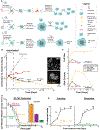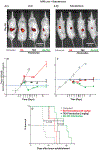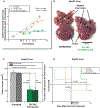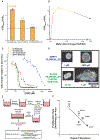Filomicelles Deliver a Chemo-Differentiation Combination of Paclitaxel and Retinoic Acid That Durably Represses Carcinomas in Liver to Prolong Survival
- PMID: 29451777
- PMCID: PMC6128960
- DOI: 10.1021/acs.bioconjchem.7b00816
Filomicelles Deliver a Chemo-Differentiation Combination of Paclitaxel and Retinoic Acid That Durably Represses Carcinomas in Liver to Prolong Survival
Abstract
Drug resistance and relapse is common in cancer treatments with chemotherapeutics, and while drug combinations with naturally occurring, differentiation-inducing retinoic acid (RA) provide remission-free cures for one type of liquid tumor, solid tumors present major problems for delivery. Here, inspired by filoviruses that can be microns in length, flexible filomicelles that self-assemble from an amphiphilic block copolymer (PEG-PCL) are shown to effectively deliver RA and paclitaxel (TAX) to several solid tumor models, particularly in the liver. These hydrophobic compounds synergistically load into the cores of the elongated micelles, and the coloaded micelles prove most effective at causing cell death, ploidy, and durable regression of tumors compared to free drugs or to separately loaded drugs. RA-TAX filomicelles also reduce mortality of human lung or liver derived cancers engrafted at liver, intraperitoneal, and subcutaneous sites in immunodeficient mice. In vitro studies show that the dual drug micelles effectively suppress proliferation while upregulating a generic differentiation marker. The results highlight the potency of dual-loaded filomicelles in killing cancer cells or else driving their differentiation away from growth.
Conflict of interest statement
The authors declare no competing financial interest.
Figures







Similar articles
-
Filomicelles from aromatic diblock copolymers increase paclitaxel-induced tumor cell death and aneuploidy compared with aliphatic copolymers.Nanomedicine (Lond). 2016 Jun;11(12):1551-69. doi: 10.2217/nnm-2016-0007. Epub 2016 May 13. Nanomedicine (Lond). 2016. PMID: 27177319 Free PMC article.
-
Micelles of different morphologies--advantages of worm-like filomicelles of PEO-PCL in paclitaxel delivery.Pharm Res. 2007 Nov;24(11):2099-109. doi: 10.1007/s11095-007-9335-z. Epub 2007 Jun 13. Pharm Res. 2007. PMID: 17564817
-
Polymeric micelles and nanoemulsions as drug carriers: Therapeutic efficacy, toxicity, and drug resistance.J Control Release. 2015 Aug 28;212:70-7. doi: 10.1016/j.jconrel.2015.06.019. Epub 2015 Jun 16. J Control Release. 2015. PMID: 26091919
-
Novel self-assembling PEG-p-(CL-co-TMC) polymeric micelles as safe and effective delivery system for paclitaxel.Eur J Pharm Biopharm. 2009 Oct;73(2):230-8. doi: 10.1016/j.ejpb.2009.06.015. Epub 2009 Jul 3. Eur J Pharm Biopharm. 2009. PMID: 19577643
-
Efficient inhibition of colorectal peritoneal carcinomatosis by drug loaded micelles in thermosensitive hydrogel composites.Nanoscale. 2012 May 21;4(10):3095-104. doi: 10.1039/c2nr30278k. Epub 2012 Apr 25. Nanoscale. 2012. PMID: 22535210
Cited by
-
Delivering Combination Chemotherapies and Targeting Oncogenic Pathways via Polymeric Drug Delivery Systems.Polymers (Basel). 2019 Apr 5;11(4):630. doi: 10.3390/polym11040630. Polymers (Basel). 2019. PMID: 30959799 Free PMC article. Review.
-
Non-spherical Polymeric Nanocarriers for Therapeutics: The Effect of Shape on Biological Systems and Drug Delivery Properties.Pharmaceutics. 2022 Dec 22;15(1):32. doi: 10.3390/pharmaceutics15010032. Pharmaceutics. 2022. PMID: 36678661 Free PMC article. Review.
-
MLL1 regulates cytokine-driven cell migration and metastasis.Sci Adv. 2024 Mar 15;10(11):eadk0785. doi: 10.1126/sciadv.adk0785. Epub 2024 Mar 13. Sci Adv. 2024. PMID: 38478601 Free PMC article.
-
CD47-SIRPα Checkpoint Disruption in Metastases Requires Tumor-Targeting Antibody for Molecular and Engineered Macrophage Therapies.Cancers (Basel). 2022 Apr 11;14(8):1930. doi: 10.3390/cancers14081930. Cancers (Basel). 2022. PMID: 35454837 Free PMC article.
-
Nanomedicine Penetration to Tumor: Challenges, and Advanced Strategies to Tackle This Issue.Cancers (Basel). 2022 Jun 13;14(12):2904. doi: 10.3390/cancers14122904. Cancers (Basel). 2022. PMID: 35740570 Free PMC article. Review.
References
-
- Chidambaram M, Manavalan R, and Kathiresan K (2011) Nanotherapeutics to overcome conventional cancer chemotherapy limitations. J. Pharm. Pharm. Sci 14, 67–77. - PubMed
-
- Tredan O, Galmarini CM, Patel K, and Tannock IF (2007) Drug resistance and the solid tumor microenvironment. Journal of the National Cancer Institute 99, 1441–54. - PubMed
-
- Kipp JE (2004) The role of solid nanoparticle technology in the parenteral delivery of poorly water-soluble drugs. Int. J. Pharm 284, 109–22. - PubMed
Publication types
MeSH terms
Substances
Grants and funding
LinkOut - more resources
Full Text Sources
Other Literature Sources
Medical

